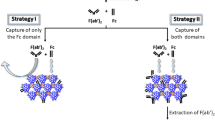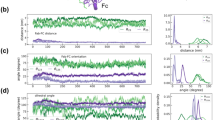Abstract
Aim:
To perform a site-specific conjugation of Fab′ fragments of a mouse monoclonal antibody(MoAb) B43(of IgG1 subtype) to a bifunctional chelator 6-[p- (bromoacetamido) benzyl]-1,4,8,11-tetraazacyclotetradecane-N,N′,N″,N′″-tetraacetic acid (BAT) via the thiol groups in the hinge distal to the antigenbinding site of the Fab′.
Methods:
B43 was cleaved using a simple 2-step method. First, stable F(ab′)2 was produced by pepsin treatment. Fab′ with free thiol in the hinge region was then obtained by cysteine reduction of F(ab′)2. Second, a site-specific conjugation of Fab′ to thiol-specific BAT was performed in a one-step reaction.
Results:
The Fab′ fragment had approximately 1.8 free thiol groups per molecule after cysteine reduction. The conjugation efficiency and the chemical yield were approximately 1.28 moles chelator/Fab′ and 74% of the initial concentration of Fab′, respectively. The F(ab′)2, Fab′ and Fab′-BAT all maintained reasonable antigen-binding properties. 67Cu labeling of the conjugate under standard conditions did not impair the immunoreactivity of Fab′-BAT.
Conclusion:
This is a simple and efficient method for producing immunoreactive conjugates of Fab′- BAT, which can be used to make radiometal-labeled conjugates for further diagnostic and therapeutic applications.
Similar content being viewed by others
Log in or create a free account to read this content
Gain free access to this article, as well as selected content from this journal and more on nature.com
or
References
Sundaresan G, Yazaki PJ, Shively JE, Finn RD, Larson SM . 124I-labeled engineered anti-CEA minibodies and diabodies allow highcontrast, antigen-specific small-animal PET imaging of xenografts in athymic mice. J Nucl Med 2003; 44: 1962–9.
Neumaier M, Gaida FJ, Lewis MR, Hefta LJ, Shively LE . A chimeric anti-CEA antibody with heavy interchain disulfide bonds deleted: molecular characterization and biodistributions in normal and tumor bearing mice. Anticancer Res 1999; 19: 13–21.
Lu ZR, Shiah JG, Sakuma S, Kopeckova P, Kopecek J . Design of novel bioconjugates for targeted drug delivery. J Control Release 2002; 78: 165–73.
Dhawan S . Design and construction of novel molecular conjugates for signal amplification (I): conjugation of multiple horseradish peroxidase molecules to immunoglobulin via primary amines on lysine peptide chains. Peptides 2002; 23: 2091–8.
Hashida S, Imagawa M, Inoue S, Ruan KH, Ishikawa E . More useful maleimide compounds for the conjugation of Fab' to horseradish peroxidase through thiol groups in the hinge. J Appl Biochem 1984; 6: 56–63.
Govindon SV, Goldenberg DM, Griffiths GL, Leung S, Losman MJ, Hansen HJ . Site-specific modification of light chain glycosylated antilymphoma(LL2) and anti-carcinoembryonic antigen(hImmu-14-N) antibody divalent fragments. Cancer Res 1995; 55: 5721s–5725s.
Griffiths GL, Goldenberg DM, Roesch F, Hansen HJ . Radiolabeling of an anti-carcinoembryonic antigen antibody Fab′ fragment (CEA-Scan) with the positron-emitting radionuclide Tc-94m. Clin Cancer Res 1999; 5: 3001s–3003s.
Smith A, Alberto R, Blaeuenstein P, Novak-Hofe I, Maecke H, Schubiger PA . Pre-clinical evaluation of 67Cu-labeled intact and fragmented anti-colon-carcinoma monoclonal antibody MAb35. Cancer Res 1993; 66: 5727–33.
Stimmel JB, Merrill BM, Kuyper LF, Moxham CP, Hutchins JT . Site-specific conjugation of serine → cysteine variant monoclonal antibodies. J Biol Chem 2000; 275: 30445–50.
Lewis MR, Boswell CA, Laforest R, Buettner TL, Ye D . Conjugation of monoclonal antibodies with TETA using activated esters: biological comparison of 64Cu-TETA-1A3 with 64Cu-BAT-2IT-1A3. Cancer Biother Radiopharm 2001; 16: 483–94.
O'Donnell RT, Shen S, Denardo SJ, Wun T, Kukis DL . A phase I study of 90Y-2IT-BAD-Lym-1 in patients with non-Hodgkin's lymphoma. Anticancer Res 2000; 20: 3647–55.
Riddles PW, Blakeley RL, Zerner B . Reassessment of Ellman's reagent. Meth Enzymol 1983; 91: 49–60.
Anderson CJ, Connett JM, Schwarz SW . Copper-64-labeled antibodies for PET imaging. J Nucl Med 1992; 33: 1685–91.
Mirick GR, O'Donnell RT, DeNardo SJ, Shen S, Meares CF . Transfer of copper from a chelated 67Cu-antibody conjugate to ceruloplasmin in lymphoma patients. Nucl Med Biol 1999; 26: 841–5.
Kukis DL, DeNardo GL, DeNardo SJ, Mirick GR, Miers LA . Effect of the extent of chelate substitution on the immunoreactivity and biodistribution of 2IT-BAT-Lym-1 immunoconjugates. Cancer Res 1995; 55: 878–84.
Weston PD, Devries JA, Wrigglesworth R . Conjugation of enzymes to immunoglobulins using dimaleimides. Biochem Biophys Acta 1980; 612: 40–9.
Imagawa M, Hashida S, Ishikawa E, Sumiyoshi A . Evaluation of Fab'-horseradish peroxidase conjugates prepared using pyridyl disulfide compounds. J Appl Biochem 1982; 4: 400–10.
Wilbur DS, Stray JE, Hamlin DK, Curtis DK, Vessella RL . Monoclonal antibody Fab′ fragment cross-linking using equilibrium transfer alkylation reagents. A strategy for site-specific conjugation of diagnostic and therapeutic agents with F(ab′)2 fragments. Bioconjug Chem 1994; 5: 220–35.
McCall MJ, Diril H, Meares CF . Simplified method for conjugating macrocyclic bifunctional chelating agents to antibodies via 2-iminothiolane. Bioconjugate Chem 1990; 1: 222–6.
Smith-Jones PM, Fredrich R, Kaden TA, Novak-Hofer I, Siebold K . Antibody labeling with copper-67 using the bifunctional macrocycle 4-[(1,4,8,11-tetraazacyclotetradec-l-yl)methy] benzoic acid. Bioconjugate Chem 1991; 2: 415–21.
Albrecht H, Burke PA, Natarajan A, Xiong CY, Kalicinsky M . Production of soluble ScFvs with C-terminal-free thiol for site-specific conjugation or stable dimeric ScFvs on demand. Bioconjug Chem 2004; 15: 16–26.
Author information
Authors and Affiliations
Rights and permissions
About this article
Cite this article
Li, J., Wang, Xh., Wang, Xm. et al. Site-specific conjugation of bifunctional chelator BAT to mouse IgG1 Fab' fragment. Acta Pharmacol Sin 27, 237–241 (2006). https://doi.org/10.1111/j.1745-7254.2006.00242.x
Received:
Accepted:
Issue date:
DOI: https://doi.org/10.1111/j.1745-7254.2006.00242.x
Keywords
This article is cited by
-
Site-Specifically Labeled Immunoconjugates for Molecular Imaging—Part 1: Cysteine Residues and Glycans
Molecular Imaging and Biology (2016)



